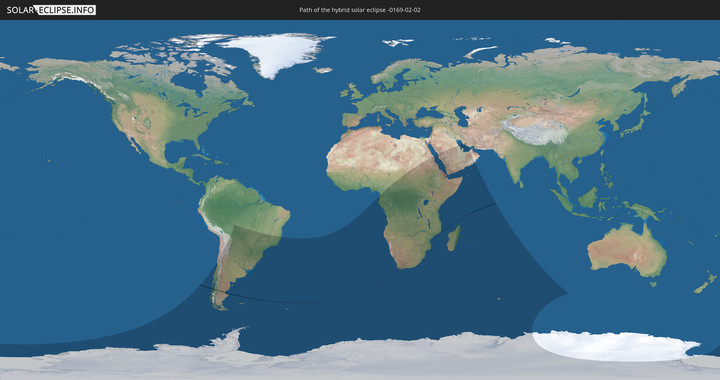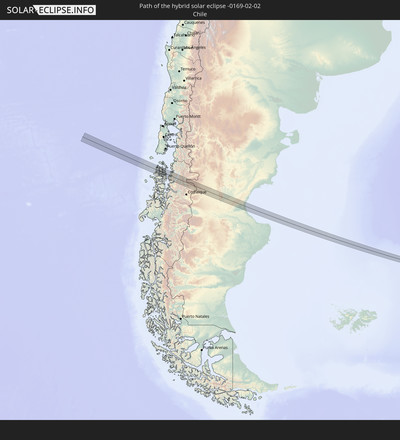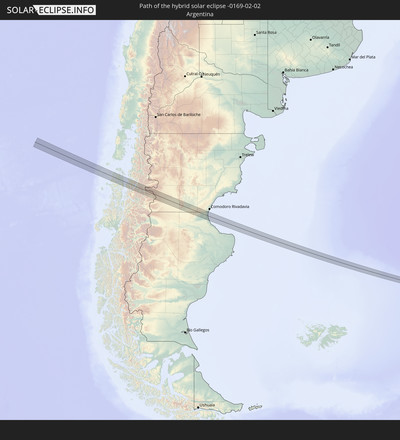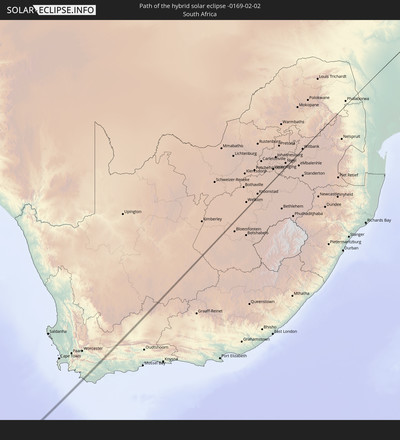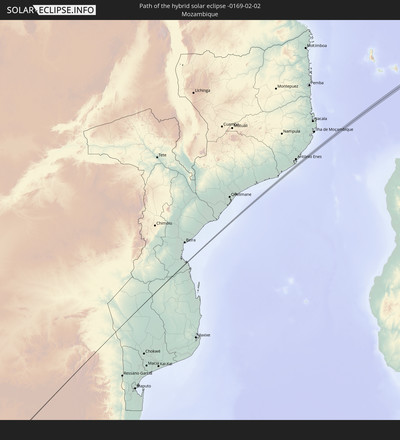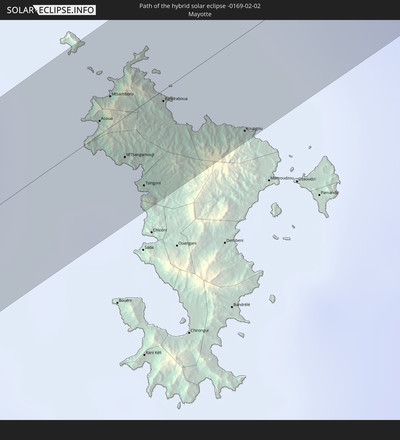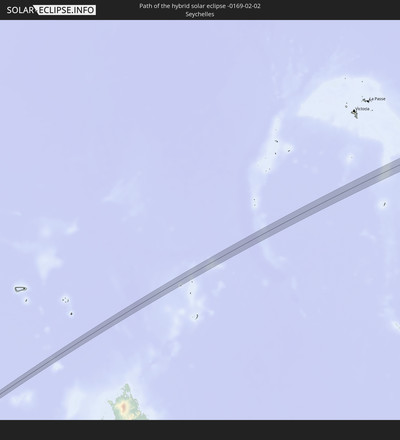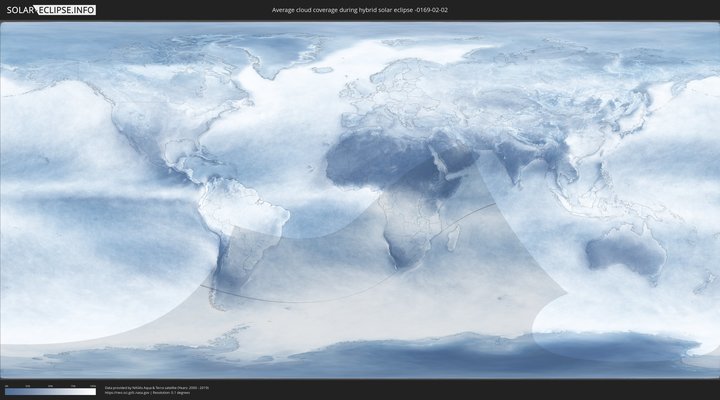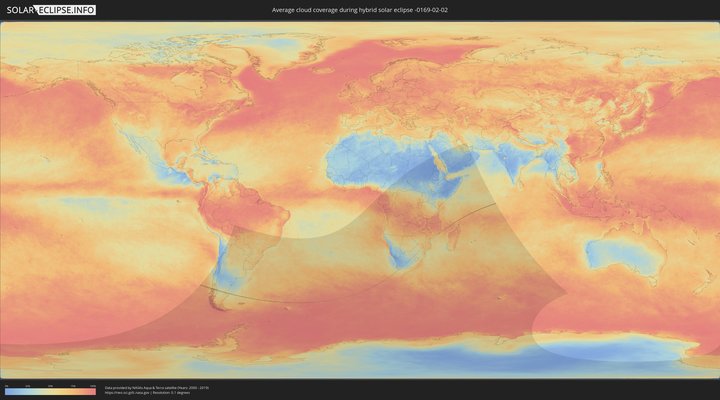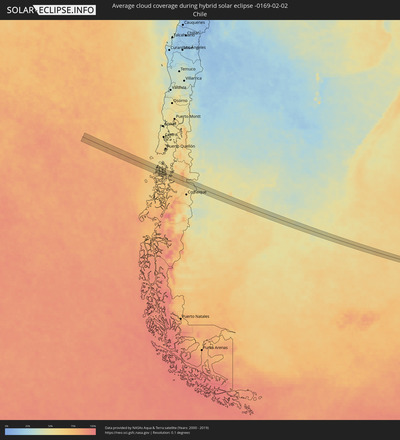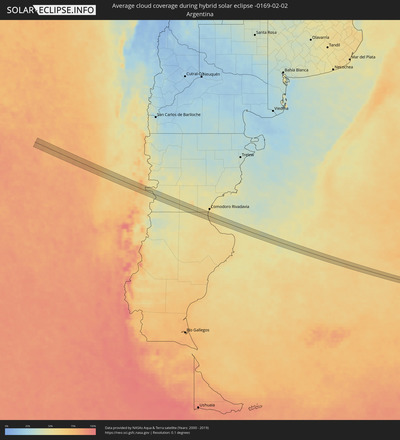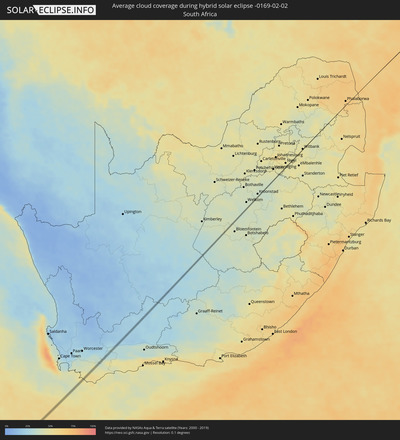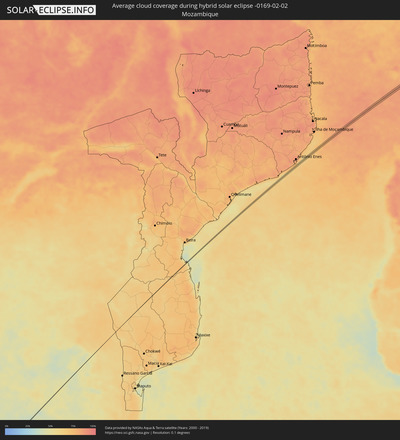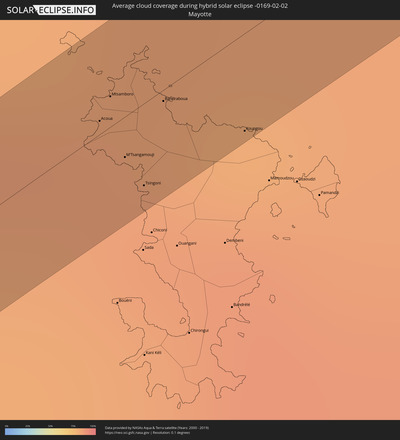Hybrid solar eclipse of 02/02/-0169
| Day of week: | Monday |
| Maximum duration of eclipse: | 00m12s |
| Maximum width of eclipse path: | 9 km |
| Saros cycle: | 57 |
| Coverage: | 100% |
| Magnitude: | 1.0023 |
| Gamma: | -0.3964 |
Wo kann man die Sonnenfinsternis vom 02/02/-0169 sehen?
Die Sonnenfinsternis am 02/02/-0169 kann man in 53 Ländern als partielle Sonnenfinsternis beobachten.
Der Finsternispfad verläuft durch 6 Länder. Nur in diesen Ländern ist sie als hybrid Sonnenfinsternis zu sehen.
In den folgenden Ländern ist die Sonnenfinsternis hybrid zu sehen
In den folgenden Ländern ist die Sonnenfinsternis partiell zu sehen
 Antarctica
Antarctica
 Chile
Chile
 Brazil
Brazil
 Argentina
Argentina
 Bolivia
Bolivia
 Paraguay
Paraguay
 Falkland Islands
Falkland Islands
 Uruguay
Uruguay
 South Georgia and the South Sandwich Islands
South Georgia and the South Sandwich Islands
 Saint Helena, Ascension and Tristan da Cunha
Saint Helena, Ascension and Tristan da Cunha
 Bouvet Island
Bouvet Island
 Equatorial Guinea
Equatorial Guinea
 Cameroon
Cameroon
 Gabon
Gabon
 Republic of the Congo
Republic of the Congo
 Angola
Angola
 Namibia
Namibia
 Democratic Republic of the Congo
Democratic Republic of the Congo
 Chad
Chad
 Central African Republic
Central African Republic
 South Africa
South Africa
 Botswana
Botswana
 Sudan
Sudan
 Zambia
Zambia
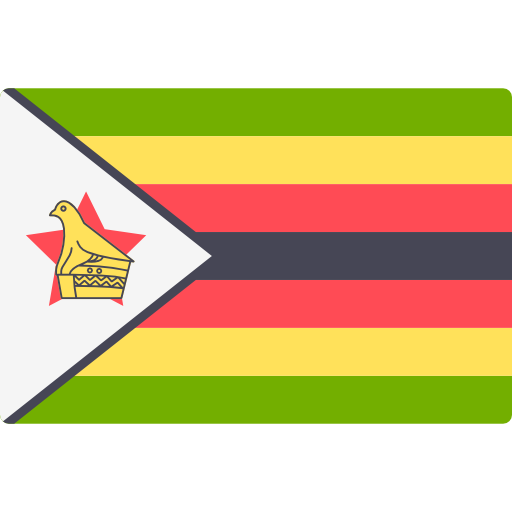 Zimbabwe
Zimbabwe
 Lesotho
Lesotho
 Rwanda
Rwanda
 Burundi
Burundi
 Tanzania
Tanzania
 Uganda
Uganda
 Mozambique
Mozambique
 Swaziland
Swaziland
 Malawi
Malawi
 Ethiopia
Ethiopia
 Kenya
Kenya
 Saudi Arabia
Saudi Arabia
 Eritrea
Eritrea
 French Southern and Antarctic Lands
French Southern and Antarctic Lands
 Somalia
Somalia
 Djibouti
Djibouti
 Yemen
Yemen
 Madagascar
Madagascar
 Comoros
Comoros
 Iran
Iran
 Mayotte
Mayotte
 Seychelles
Seychelles
 Bahrain
Bahrain
 Qatar
Qatar
 United Arab Emirates
United Arab Emirates
 Oman
Oman
 Réunion
Réunion
 Mauritius
Mauritius
 Heard Island and McDonald Islands
Heard Island and McDonald Islands
How will be the weather during the hybrid solar eclipse on 02/02/-0169?
Where is the best place to see the hybrid solar eclipse of 02/02/-0169?
The following maps show the average cloud coverage for the day of the hybrid solar eclipse.
With the help of these maps, it is possible to find the place along the eclipse path, which has the best
chance of a cloudless sky.
Nevertheless, you should consider local circumstances and inform about the weather of your chosen
observation site.
The data is provided by NASAs satellites
AQUA and TERRA.
The cloud maps are averaged over a period of 19 years (2000 - 2019).
Detailed country maps
Cities inside the path of the eclipse
The following table shows all locations with a population of more than 5,000 inside the eclipse path. Cities which have more than 100,000 inhabitants are marked bold. A click at the locations opens a detailed map.
| City | Type | Eclipse duration | Local time of max. eclipse | Distance to central line | Ø Cloud coverage |
 Sarmiento, Chubut Province
Sarmiento, Chubut Province
|
annular | - | 06:13:09 UTC-04:16 | 21 km | 52% |
 Virginia, Orange Free State
Virginia, Orange Free State
|
total | - | 14:20:44 UTC+01:30 | 1 km | 41% |
 Hennenman, Orange Free State
Hennenman, Orange Free State
|
total | - | 14:21:12 UTC+01:30 | 1 km | 40% |
 Acoua, Acoua
Acoua, Acoua
|
annular | - | 16:01:15 UTC+02:27 | 1 km | 85% |
 Mtsamboro, Mtsamboro
Mtsamboro, Mtsamboro
|
annular | - | 16:01:18 UTC+02:27 | 3 km | 85% |
 M'Tsangamouji, M'Tsangamouji
M'Tsangamouji, M'Tsangamouji
|
annular | - | 16:01:13 UTC+02:27 | 4 km | 82% |
 Tsingoni, Tsingoni
Tsingoni, Tsingoni
|
annular | - | 16:01:11 UTC+02:27 | 7 km | 82% |
 Bandraboua, Bandraboua
Bandraboua, Bandraboua
|
annular | - | 16:01:19 UTC+02:27 | 1 km | 85% |
 Koungou, Koungou
Koungou, Koungou
|
annular | - | 16:01:18 UTC+02:27 | 9 km | 86% |
